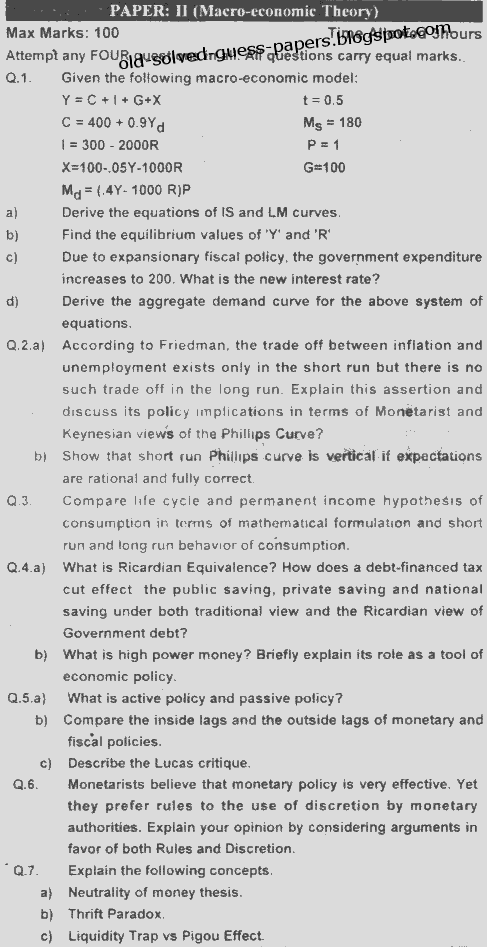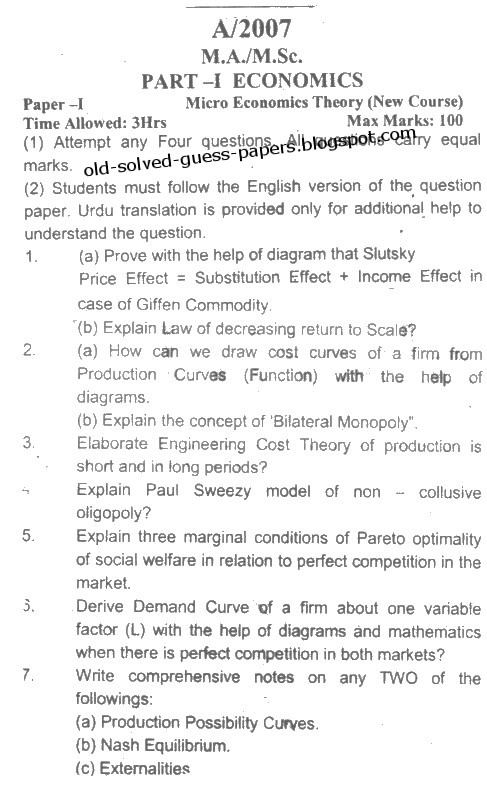|
#2
4th August 2015, 03:48 PM
| |||
| |||
| Re: Guess paper for M.A Economics Punjab University
As you want to get the previous year question papers for M.A Economics Punjab University so here is the information of the same for you: Syllabus of M.A Economics Punjab University: PAPER I : MICRO-ECONOMIC THEORY AND WELFARE ECONOMICS: UNIT-I: Scope of Microeconomics. Methodology of economics as a positive science. Criteria for choosing among alternative theories. Dynamic economic analysis and Cobweb theorem. Partial vs general equilibrium analysis. Marshallian and Walrasian stability conditions. Demand Analysis: Ordinal utility theory. Revealed preference theory. Market demand : Bandwagon and Snob effects. Measures of consumer’s surplus. Markets and Asymmetric information : Quality uncertainty and the market for lemons; Market Signaling : A simple model of job market signaling. Neumann-Morgenstern method of measuring utility. Risk aversion and risk preference. Risk return trade-off. UNIT–II: Production and Costs: Technology and production function. Cost minimising equilibrium and choice of technique and scale. Effects of a change in factor price and elasticity of factor substitution. Expansion path and derivation of long run cost curves. Homogeneous production functions and resultant shapes of long run cost curves (a geometric exposition only). Sources of various economies and diseconomies of scale. Economies of scope. Learning curve and production costs. Saucer shaped and L-shaped long run average cost curves. Productivity curves of variable factors and derivation of short run cost curves. Concept of idle capacity. Saucer shaped average variable cost curve. Relationship between short run and long run cost curves. Multi-product firm equilibrium. UNIT–III: Perfect Competition: Welfare effects of price controls, price supports and production quotas. Classical allocative efficiency due to perfect competition vs. production efficiency due to the emergence of important scale economies. Monopoly: Measurement, determinants and welfare effects of monopoly power. Price regulation. First, second and third degree price discrimination. Inter-temporal price discrimination and peak load pricing. Pricing under bilateral monopoly. Monopolistic Competition: Group equilibrium. Selling costs equilibrium. Excess capacity and Chamberlin’s answer. Oligopoly: Definition and nature. Cournot’s model. Kinky demand curve model. Dominant firm and low cost firm price leadership models. Stackelberg’s model. Collusion or Cartel model. Bain’s limit pricing theory. Marginalism vs. Average cost pricing. Profit maximisation vs. Baumol’s sales maximisation hypothesis. UNIT–IV: Game Theory: Definition, objectives and usefulness; Dominant strategy and Nash Equilibrium; Prisoner’s Dilemma, Price and Non-price competition and Cartel Cheating; Repeated Games and Tit-for-Tat strategy. Euler’s theorem: Inter-temporal consumption choice and Fisher’s theory of the rate of interest. Welfare Economics: Pareto-optimality conditions in production, consumption and exchange. Efficiency of perfect competition and inefficiency of imperfect competition. Market failure due to externalities in production and Pigou’s solution of taxes and subsidies. Inter-personal comparisons of utility and the compensation criteria. Utilitarian, Rawlsian and Bergson-Samuelson social welfare function and optimal social welfare. PAPER II OPTION (i) : INDIAN ECONOMY : ISSUES AND PROBLEMS: UNIT-I: (i) Indian Economy at the Dawn of Independence: A Review. Planning; Objectives; Rationale and Performance; Adoption of mixed economy model; economic planning in the nineties and beyond. (ii) Restructuring of the Economy: State of the economy in 1990-91; need and features of Structural Adjustment Programme (SAP); Globalization and WTO in India; Appraisal of economic reforms. UNIT-II: (i) Growth & Structure of Indian Economy since 1950: Growth of National Income and Per Capita Income, Personal Income Distribution in India. Demographic features : Population Growth, Workforce participation, occupational structure; urbanization in India; Inter-state disparities in the pattern of development. (ii) Poverty and Unemployment: Nature, extent and regional variations in poverty and unemployment; government programmes for eradication of poverty and unemployment with special reference to the post-reform era. UNIT-III (i) Agriculture: Pattern of growth of Indian agriculture and constraints thereon; regional variations in agricultural development. Sustainable agriculture – Need and Policies. Recent agricultural policy of Govt. of India. WTO and Indian agriculture. (ii) Industry: Trends in growth and structure of Indian industry; regional disparities in industrial development; deregulation and liberalization of the private sector; public sector reforms and privatization. Impact of New Economic Policy on Indian Industry. Rationale, objectives and functioning of Consumer Protection Act (1986). For more detailed information I am uploading a PDF file which is free to download: Previous year question papers for M.A Economics Punjab University:    Contact Details: Panjab University Chandigarh Sector 14 Chandigarh, 160014 India Map Location: [MAP]Panjab University Chandigarh Chandigarh[/MAP] |
